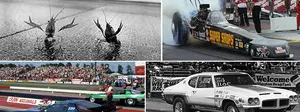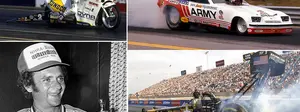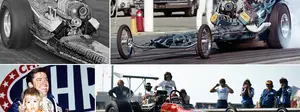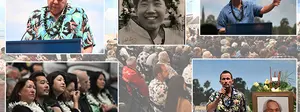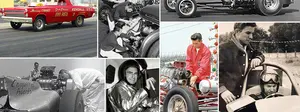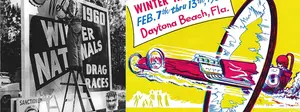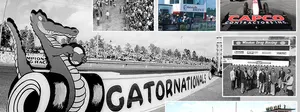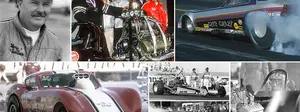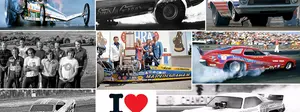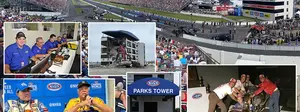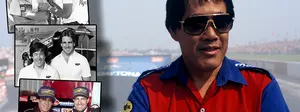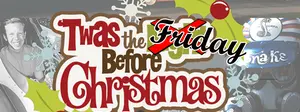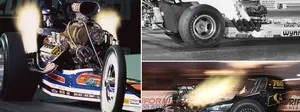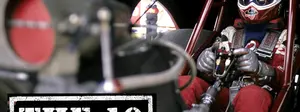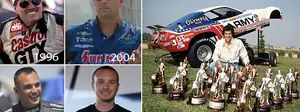Location, Location, Location
 Steve Reyes |
Growing up as a young drag racing fan in the early 1970s, I couldn’t get enough of the monthly drag racing magazines that carried me to far-off dragstrips that I knew I’d never visit and introduced me to the latest cars and stars of the sport. The beacon of our sport then was Drag Racing USA, which always seemed to draw the finest photographers from the merry band of wanderers who crisscrossed the country, following the scent of nitro to whichever dragstrip regardless of sanctioning flag (or lack thereof!) had the hottest action.
The car features were always a treat, multiple color spreads of cars so new that the paint was almost still wet. Sometimes the cars were shot in parking lots or pit areas, but many had photos that bordered on art, with exotic locations that were car-appropriate or just weird enough to catch the fancy of Mike Doherty, DRUSA editor/publisher. Our good friend of the Insider, Steve Reyes, was among a group that included guys like Jere Alhadeff, Jon Asher, Jim Kelly, Alan Earman, and Tim Marshall, and he agreed to share the stories behind the stories of some of his more memorable photo shoots.
The band of gypsy photographers that traveled the same road had a friendly camaraderie “on tour” – which often included shared cars, motels, and meals – that was valued by all, but each still had to earn his own way.
“I made a pretty good living doing that, but it was all on speculation, and I paid all of my own expenses,” recalled Reyes. “For the car features, I just picked them, or guys would call me to tell me about their new cars – I knew all of the owners and drivers and sometimes went on tour with them – and I’d drive or fly wherever and bust my ass to make it a nice shoot, but there was no calling a magazine and saying, ‘Hey, I need $600 to go to Tulsa, Okla.,’ to shoot a car or a race. You’d come in with your best photos, and the best material got purchased. If you came in with crap, you went home with crap. I didn’t want to leave with crap; I wanted something unique.
 Jon Asher, left, and Reyes at the 1973 Gatornationals. Would you let these guys shoot your car? Of course you would! |
“I certainly wasn’t the first to do it,” he admitted. “I remember seeing the Allen family – whose cars were named Stinger and Wasp – dressed up in beekeeper suits – on the cover of a magazine. Ralph Gudahl Jr. shot the Walton & Allen car in front of an old train in Griffith Park, and Tim Marshall shot the Creitz-Greer car in front of the fountains at Caesars Palace. I thought that I’d like to do that kind of stuff; I wanted something different, something eye-catching, something majestic, and Mike liked that kind of stuff. Doherty really liked the eye candy; he cared more about the shot than he did the significance of the car in the photo.”
Reyes admits that half the battle was securing access to shoot at the location – he always succeeded, except at Disneyland – with a promise that the business or whatever would end up in national magazines. His late ex-wife, Barbara, often succeeded where he couldn’t. “She could sell ice cubes to an Eskimo,” he remembers fondly. “She got my foot in the door at a lot of places that were not keen on the idea at first. She’d tell them about all of the national exposure they get and so on.”
And it turns out that the guy best known for being in the right place at the right time when bad things happened to good cars on the dragstrip was also very good at capturing the images when they were standing still. In that golden era, from roughly 1971 to 1974 before he joined Argus Publishing and shot exclusively for its magazines (Popular Hot Rodding, Super Chevy, et al), Reyes shot scores of these car features that ended up in various magazines, usually accompanied by a cover photo, and the tales that accompany the images are almost as good as the photos themselves.
This is the first of two parts. Enjoy!
 |
From a logistical standpoint, Reyes’ photo shoot with Dennis Fowler’s Rat Trap Funny Car, the blue and gold Satellite surrounded by elephants, was among the more dicey that he handled. Photographed at Lion Country Safari, a large, drive-thru tourist attraction across the 405 Freeway from Orange County Int’l Raceway (if you turned west off the Moulton Parkway exit, you went to Lion Country Safari to see lions and elephants; turning east took you to OCIR to see Mustangs and Barracudas). A cartoon elephant chasing a rat on the side of Fowler’s car was part of Reyes’ inspiration; the other part came from fellow pro Earman’s photo shoot there with Tom McEwen’s Funny Car surrounded by cheetahs (as hilariously recounted by McEwen in his book, Mongoose: The Life and Times of Tom McEwen).
 |
“Because Earman had already done this, it wasn’t hard to also get to shoot there, but that was the easy part. We unloaded the car, and the trainers spread hay all around it to attract the elephants. At one point, though, the largest bull elephant came towards the car and raised its foot like it wanted to stomp on the front of the car; I don’t know if it was a threat to him or he didn’t like the color or what. This 120-pound trainer ran over and started to beat the elephant with a large bamboo stick. I figure I’m going to end up instead with a photo for the National Enquirer of this guy getting turned into a pizza: Man Dies From Elephant Wounds. But, sure enough, the elephant turned and scurried away.
“The other problem I had was that we had to shoot it while the park was open to the public, so cars were driving by on the road behind the elephants. We were in the middle of the compound shooting out towards the road. Today, we would just Photoshop the cars out, but we didn’t have anything like that back in the 1970s, so I was ducking and weaving and trying to use the elephants and the car to block out the cars. I had to try to time it just right, but you can barely see a car in the shot above [between the nose of the car and the elephant's leg].”
 |
For a period of time, one of Reyes’ favorite spots was a parcel of undeveloped land along California’s Long Beach Harbor across from the Queen Mary luxury liner’s mooring. The area was destined to become condos and already had paved streets leading to it that were perfect for trailering a car right to the location. Among the cars that Reyes shot there was Robert Andersen’s Top Fueler, Shirley Muldowney’s Satellite Funny Car, Dave Bowman’s rear-engine Vega panel Funny Car, the L.A. Hooker, and Stone, Woods & Cook. The Long Beach police would drop by to check out the goings-on but usually just ended up ogling the cars, remembers Reyes.
One photo shoot there that didn’t go so easily was for the nighttime photo of Andersen’s dragster, shown above. “This was tough from a technical standpoint because of the lighting and because of the setup,” Reyes recalled. “Tom West would help me with the lighting. Usually, it was just me and the driver; we’d take the car out and set up the shoot, but Tom would help me with the strobes and the metering. Then, because the ship was all the way across the harbor, I had to use a telephoto lens to visually pull the ship closer.
 |
“Then, midway through the shoot, a Coast Guard helicopter shows up to investigate what we were doing because we were firing off the strobes and someone had reported them as gunshots or explosions. They had their spotlights on us and yelling at us, ‘What are you guys doing down there?’ We hadn’t asked for permission, and we had no permits, but once they saw we were only shooting photos, they left us. They didn’t send SWAT to come get us or anything, so that was good. I remember shooting a huge fire burnout with Herm Petersen one year at Pomona that someone reported as a plane crash. The next thing we know, all of this fire apparatus is rolling up on us. We had to do some fast talking to get out of that one.”
Muldowney’s new Satellite was fresh out of the paint shop when Reyes shot it across from the Queen Mary, and Reyes had earned the hard-won trust of the First Lady of Drag Racing with a shoot of her Mustang. Painter Don Kirby and Kenny Youngblood both had vouched for Reyes, which opened the door to his first shoot with her, which ended up on a cover, so the next one was easier. Muldowney still was based out of Michigan but had a base in Los Angeles while waiting for the car to be finished. In this photo, she’s actually wearing an outfit borrowed from Barb Reyes.
When Muldowney had her first Top Fueler built (which surprised a lot of people), Reyes was her first call, and they shot it at a park in Southern California’s Playa del Rey area, near where both were living, and it, too, ended up on the cover of Drag Racing USA, in May 1974. Because Reyes was supposed to be working exclusively for PHR by then (and because the statute of limitations has probably run out), he admits that he submitted the photos (and many more afterward) to DRUSA with photo credit to Barb.
 |
Reyes shot this memorable photo of the Taco Time Vega Funny Car of Joe Colello and Gary Cromwell at one of the Taco Time restaurants while he was in Seattle for the Seafair Funny Car event in 1971. Colello was a successful grocery store owner and well-known businessman in the area and had secured the Taco Time deal, and he called a local outlet to set it up.
“I was staying with Joe during the race, and he did all of the legwork to get us there,” said Reyes. “They welcomed us with open arms. I think it was a Friday night. The customers were really cool. We put the car in position, waited for the sun to go down, and no one bothered us. And they even fed us. After we were done, the customers all came over and checked out the car.”
I featured this car in 2009 when I was doing the letter C for the Misc. Files collection and noted that the Taco Time chain had grown from a single store in Eugene, Ore., in 1959 to more than 350 locations. I'm sure Reyes' photo helped. "I always thought that maybe if I shot a photo of a car in front of a Jack in the Box or something they might advertise in the magazine, too," said Reyes.
I don't know if that ever happened (kinda doubt it), but Reyes did shoot a couple of features at California Jack in the Box restaurants, where again he was greeted with open arms, even without a primary introduction. “People were always very cool; it was surprising how accommodating they could be," he marveled.
 |
 |
The memorable photo above (included in the Keeling & Clayton thread) was shot at a Northern California Jack in the Box and was the result of some rumbling stomachs. “Me and [Tom] Ferraro and one of their crew guys had already shot a feature on the car in a nearby soccer field, and we were hungry. Ferraro liked eating at Jack in the Box, so we pull in there, and I mention to Ferraro that this would make a nice photo. There was even a guy already there dressed up like Jack. We unloaded the car, and the manager thought we were the greatest thing since sliced bread.”
The photo of the twin-engine Syndicate Top Fueler in the drive-thru was shot at a Southern California location. “Same deal. I told them who I was, who I shot for, and what I wanted to do, and they told us we could come back when it was their slow time. So we show up at o’dark-thirty, they closed the drive-thru for us, and we shot it.
“The funny part of this story is that we were on deadline, so me and Tom West had to rush to the film processor’s place in Glendale, Calif., to get it in the mail to Doherty. I hand the bag of film to West to drop it into the night drop, but he accidentally dropped it into a U.S post office mailbox. It was midnight, and we had to go find the postmaster to get the film back. It took us two hours to find the guy, explain what was going on, show him our IDs, and convince him to open this mailbox for us. He was very cool and helped us out; Tom sheepishly walked over and made the correct drop, and the photo eventually ended up on a cover.”
 |
 |
Reyes and Dave Motta were in Northern California on their way to the beach in Santa Cruz to shoot a feature on the new Motta & Williamson rear-engine Hairy Canary Challenger Funny Car when Reyes spied something unusual off the side of the freeway.
“We’re rolling down the highway, and I look out my window, and I see some freaking dinosaurs! Whoa! We take the next off-ramp, make a loop, and head off down this bumpy little two-lane road, and here’s Joe Blow’s Dinosaur Land or something, just this display of about a dozen giant dinosaurs this guy had made. There were, maybe, one and a half customers there at the time. So I talk to the guy – a nice, older guy – and I told him I’d put his dinosaurs in a magazine, so we set the car up and had a really nice shoot. It made a nice center spread and later was made into a poster called Beware of the Bird. I sent the old guy some photos, too.”
OK, gang, that’s it for Part 1 of Location, Location, Location. I’ll have Part 2 next Friday, which includes memorable photo shoots with fuel altereds that were as wild as the machines themselves. Thanks again to Steve for his great stories of these wonderful and memorable photos that made magazine reading in the 1970s an adventure, too!















